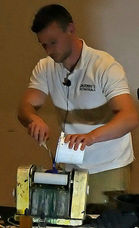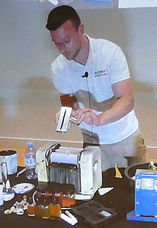

Birstall and District Art Society
Talk and demonstration by Marc Jackson
Local paint manufacturer - Jackman's Art Materials
Marc’s father was in art all his life until he became too ill. Having been an accountant and not enjoying it, Marc came up with the idea of making paints and has not looked back. In fact it turned into an obsession.
They now make watercolours, acrylics, Indian inks, gouache and crystalline paint (similar to Brusho but more colour-fast).
To make a watercolour, pigment is suspended in Gum Arabic solution, which is tree sap. Marc passed around solid samples that are derived from acacia. It can be bought as powder or solid form. Handpicked selected grade Gum Arabic is used to avoid residue from the ground that can be incorporated in powder form.
To dissolve the solid, it is added to liquid and strained through muslin like jam. The water is distilled, i.e purified. It is then heated to 50 degrees to help the gum dissolve. A higher temperature will scald the gum. It is mixed gently to avoid bubbles. It will take a few weeks to dissolve. Batch size is about 15 kilos a time. What is left is a pale amber colour.
The company started in 2019 and lockdown gave plenty of time for experimentation. Marc’s father was a lab assistant and so had a basic knowledge to which he added with research.
Humectant is used in watercolour to stop it from flaking. Marc uses vegetable glycerine which is transparent and odourless. Some manufacturers use honey, but of course it is sticky, has colour and a taste. Also it is less easy to control as it can vary so much in colour and form.
With too much humectant in the paint it won’t dry properly. Too little Gum Arabic it won’t adhere properly. Paint can contain bugs which make it go off which produces moulding, so a cosmetic grade preservative is used to stop this process.
Pigment is used rather than dyes which would wash away and fade. Plastics, automotive and cosmetics industries dictate which pigments are produced. If it is no longer needed then it disappears from the market. Buying from a manufacturer gives consistency and making them could be dangerous and potentially illegal. Pigments are purchased in quantities of 1-25 kilos.
Ultramarine originally came from lapis lazuli but has been synthesised. There are now several manufacturers producing a very slight variance in different hues. Marc does the initial testing and then they are sent out to artists. A majority vote is taken.
Batch size will be 1-2 kilos for own brand. Marc also manufactures for other brands where batch size might be 20 kilos. Three-point accuracy digital scales are used.
Marc demonstrated how different micron sizes (powder sizes) can change the colour. Pigment numbers are no guarantee of consistency.
Different pigments are easier to mix with water. Some colours are ‘hues’ to replace pigments that are considered toxic. Marc told us that all are safe once they are mixed.
Wetting the pigment into the binder can be mixed like making a cake. This is called wetting out. For larger volumes a mixer is used. Marc now uses a high dispersal mixer. The pigment then has to be evenly dispersed across the binder. A muller can be used, like a large pestle with a flat bottom, hence ‘mulling it over’. A friend of his father’s donated his mill. It has ceramic rollers. A metal such as steel would heat up and eventually could affect the colour. Colour is poured in one end and comes out transformed at the other end. Wheels can be adjusted to increase or decrease granulation.
Marc does not currently produce pans as they are more labour intensive and take up more space. He recommends filling your own with a small amount of paint.
Marc explains how he keeps his colour consistent: buying from same manufacturer, keeping good notes and using accurate scales. A fineness of grind gauge is used to test the particle size. The paint is drawn down and where it scratches is the largest particle size. Different colours have different requirements. If it scratches at a larger than acceptable size it is run back through the mill. Looser rollers are used to avoid it going too far. A density cup is used to check density by weight full against empty. Pigments will have a different weight so the tube weights will vary.
Marc will take swatches with different techniques to check how the paint is brushing out. One of Marc’s best selling colours sage green was made by accident.
Aluminium tubes are bought from Germany. Sadly the only UK factory was forced to close due to increasing energy costs. Marc explained how the tubes are made by extruding the aluminium into a tube shape and lacquering inside and out. Marc fills by hand using an oil syringe. Each tube is pinched to get rid of air and then sealed with a hand operated crimping machine and then labelled by hand.
Meg Grant








